The eldest brother
One of New Zealand’s great natural sites is Aoraki: Mt. Cook.  Seen by the Maori as the eldest brother in the capsized canoe that came from the mythical homeland, Hawaiki, the mountain is sacred, the tallest in New Zealand.
Mt. Cook was high on our list of things to see/places to sleep. But only if the weather cooperated. The Mt. Cook region gets 60 days of sun each year. That’s 60 days where you can even see the sun at all. And, because of the South Island’s crazy insane weather systems, it can be nearly impossible to predict what the weather will be doing on any one part of the island at any given time.
When we headed toward the mountain form Dunedin and the south, the weather was beautiful. If the weather held, we would spend at least one night in a Department of Conservation campsite at the base of the mountain, one of the most popular camp sites in the country.
I drove and Krista scanned the guidebooks, deciding where we would stop to take pictures and evaluate the weather. There was a viewpoint that would allow us a peek up at the mountain from the southern tip of Lake Pukaki. If we could see the mountain, it was game on.
Pulling into the visitor center parking lot, we had our answer.
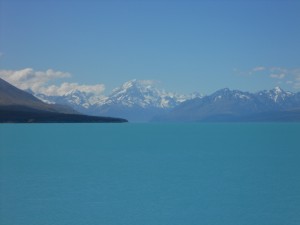
We’d seen the lake before the mountain. It was eerie blue, the kind of blue that comes only from the super-fine silt of glaciers. It looked like some kind of strange energy drink, electric and milky. I kept looking at it in disbelief, marveling at the trick of the light that made the water look so dense.
We were on our way to the mountain. If it looked great from a distance, we were going to see it up close, too. Back in the van, we scooted along the road to its terminus. New Zealand is an interesting place for a lot of reasons. It’s beautifully set up for travelers. The roads are good, but they take you to immensely remote and rugged places. It’s kind of like a huge theme park for would-be explorers.
Mt. Cook, while a major destination, has a large and well-outfitted campground, an enormous Conservation information center dedicated to the history of Sir Edmond Hillary (the first guy to summit Everest was a kiwi) a big-sized hotel/lodge, a couple of hostels, and a few restaurants. A handful of homes complete the village, presumably housing those who staff the hotel.
From the village we were treated to some excellent views of Mt. Cook and the surrounding mountains, complete with their spectacular hanging glaciers.
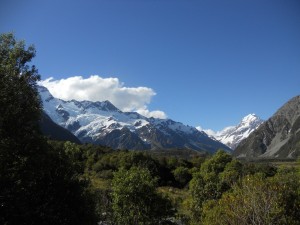
Per our usual routine, we checked in at the Department of Conservation info center to get a weather update and a suggested hike for the evening. The weather report was good. At least one day more of sun was expected, and we’d be able to get a great sunset view of Aoraki from Kea Point, a 30 minute hike from the campground.
So that’s where we headed. The sand flies, which had been gloriously absent for the past week, were still granting us a reprieve at the campsite as we cooked dinner and set up for the evening. The campsite even had fantastic flush-toilets and potable water. Our bellies and canteens full, we checked our watches, did some calculations and headed toward Kea Point, hoping for a bit of time to sit and take in the mountain as the sun climbed its slopes.
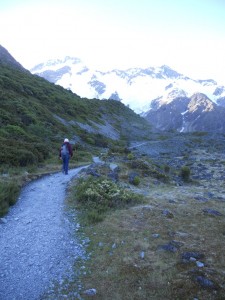
Kea Point was perfectly situated to watch the sunset. It sat just above a glacial lake, to the side of the mountain that blocked Aoraki from view at the campground. From the viewing platform, we looked out across the lake at Mueller Glacier and up at Mt. Cook.
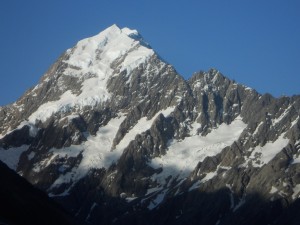
We looked at the hills and mountains all around us. And then we realized that we were standing too still, for too long. Sunset is precisely the time that the sand flies are the worst.
We tried to tough it out. We could tell by the light on the mountain that we had maybe 20 minutes before the sun would set completely and we might see some color on the beautiful glaciers.
Twenty minutes was too long to wait. We smacked each other and ran in circles trying to get the flies to dissipate, but it was no use. We breathed in the mountains and the delicate light on the glaciers, and then we made a break for it.
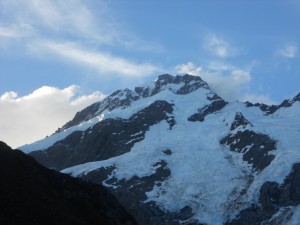
We’d see more of the mountain tomorrow.
***
The plan for the day was two-fold. First, head to the Tasman Glacier (New Zealand’s largest) for a view of Mt. Chudleigh and a gander at the icebergs. Yes, the icebergs.
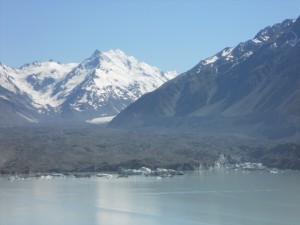
After a bit of a drive, it was a quick walk out to the glacier. Though it was the largest, it was covered in shale and other rock, disguising the vast amount of ice beneath. Only the floating chunks of ice, and glacial lake gave it away.
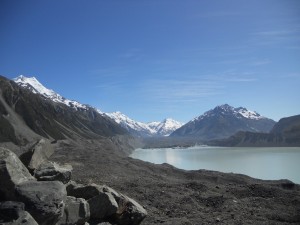
But the best view, in my mind, was the look back at the glacial valley. The flat-bottomed expanse left behind by the retreating glacier, and kept alive by the constant melt.
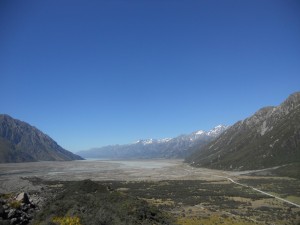
We took some time to sit and soak in the mountains and the sky. New Zealand is good for that. When the sky is clear, it’s the color blue that I’ve seen very few places. The sky, with white stretches that look like the spraycan function in Microsoft Paint, give name to the islands –  Aotearoa: land of the long white cloud.
The second part of our plan for the day was to find excellent views of the mountain. This required a long hike out to the Hooker Glacier, on the other side of Mt. Cook.
The space around the village and glaciers already felt remote, but the hike on this afternoon felt removed. It was almost as if we were arriving directly after the trail had been cut. Directly after the area had first been seen by people. It felt raw.
Immediately, scenes presented themselves to us and our cameras. The kind of scenes that could be – that probably are – postcards.
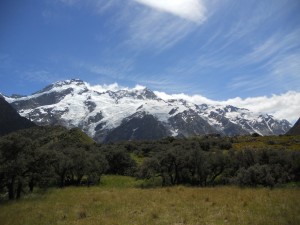
We crossed swing bridges spanning milky rivers and climbed through the spear ferns waiting for the mountain to come into view.
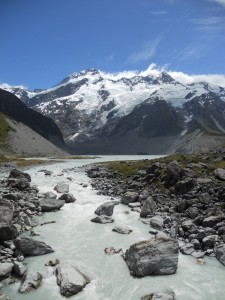
The wind that was keeping the skies so clear whipped around us, funneled across the ice and down the valley. The sun, working equally hard, beat down, warming us and giving the scene a vibrant, sometimes neon glow.
When the trail moved out from the hillside where it had been clinging, we saw what we were looking for. And, with every step, Aoraki presented itself more and more fully.
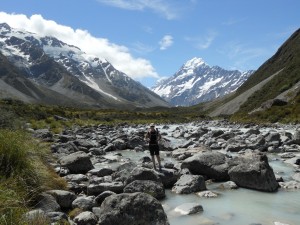
Right up until we reached the huge lake at the head of the glacier. I have no doubt we could have cut our hike in half, if we had been able to refrain from photographing the mountain every 3 seconds as the view changed. As it was, we kept snapping shots and gaping at each other.
Our timing, this day like most others on our trip, was ideal. We arrived at the base of the mountain as the few other people on the trail in front of us were leaving. It was quiet, but for the nagging of the wind, stretching the last, stubborn clouds across the sky.
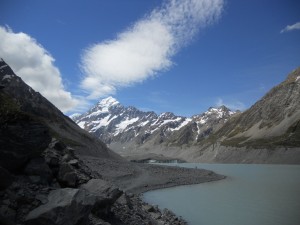
We picked a spot between two streams fed by waterfalls and sat to view the eldest brother.
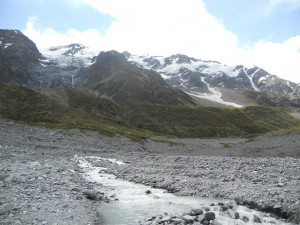
Filled up by the ancient mountains, we noticed the shift in the wind’s tone. Now more fierce than complaining, it told us it was time to leave. And, as we did, we watched the clouds that had threatened for hours to obscure the mountain slide closer. The mountain had been good to us.
Of the 60 days of sun the mountain would see that year, we had three of them. W e were grateful for our continuing good fortune.
Walking back to the campground, we were treated to more beautiful views, including the distant, fluorescent blue of Lake Pukaki.
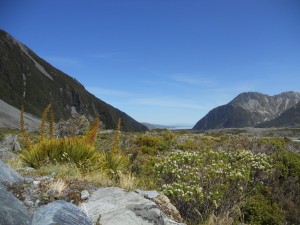
And, though we felt like explorers moving through New Zealand’s wilderness, we found ourselves at the base of the Mt. Cook alpine memorial, reminded of those who truly delved into the unknown in order to find the mountain.
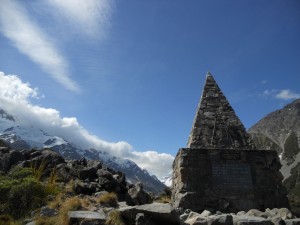
Grateful, we moved on, leaving the mountain to the clouds.



1 comment
You should be writing for travel bureaus in each of the countries you visit!